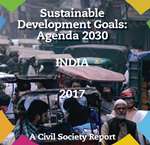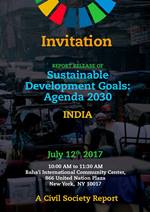India
Published on Thu, 2020-01-30 10:08
In India the official VNR's main point is that rapid economic growth has sharply reduced poverty. A 2018 study backs this claim saying extreme poverty is declining in India at rate of 44 people per minute as a result of which, since May 2018, India claims to no longer have the largest number of poor people. Despite this dramatic poverty reduction, over 73 million Indians still live below the international poverty line. Most of these people subsisting on less than US$1.90 a day are in rural areas. Even as the absolute numbers of poor fall there is rapid rise in inequality. A 2018 Oxfam report says India’s richest one percent garnered 73 percent of national wealth generated in 2017.
|
Published on Fri, 2019-04-12 09:27
The Government of India presented its first Voluntary National Review (VNR) report on Implementation of the Sustainable Development Goals (SDGs) to United Nations in 2017. Despite VNR guidelines urging countries to inform on “progress and status of all SDGs”, India reported on only seven goals. This is surprising as India’s VNR claimed its national development goals are “mirrored in the SDGs” and as Government had asserted 11 of 17 SDGs were already being worked on even before the SDGs were adopted. Given the consensus that SDGs’ success largely depends on India’s achieving them, an appraisal of its performance in critical social sectors, including those associated with the SDGs left out of VNR, becomes necessary.
|
|
The Government of India presented its first Voluntary National Review (VNR) report on Implementation of the Sustainable Development Goals (SDGs) to United Nations in 2017. Despite VNR guidelines urging countries to inform on “progress and status of all SDGs”, India reported on only seven goals. This is surprising as India’s VNR claimed its national development goals are “mirrored in the SDGs” and as Government had asserted 11 of 17 SDGs were already being worked on even before the SDGs were adopted. Given the consensus that SDGs’ success largely depends on India’s achieving them, an appraisal of its performance in critical social sectors, including those associated with the SDGs left out of VNR, becomes necessary.
|
|
Source: 
. Published on Mon, 2018-04-16 00:00
For the first time the State government this year presented a Gender Budget Statement as part of the annual budget documents, quantifying the allocations that will benefit women during this fiscal.
The statement appears as the last chapter in the appendices to the Budget documents published by the Finance Department and tabled in the Assembly on March 15. The Budget speech by Finance Minister O. Panneerselvam did not mention it.
|
Published on Mon, 2018-04-16 00:00
The Indian state government of Tamil Nadu this year presented a Gender Budget Statement as part of the annual budget documents, quantifying the allocations that will benefit women during this fiscal year. Finance Secretary K. Shanmugam said it is the first time such an exercise has been undertaken. Kamakshi Sundaramurthy, senior researcher of Social Watch Tamil Nadu, said the gender budget does not address the needs of sub-categories among women, such as those from among the minorities, Dalits and sub-castes. “These women need better education, healthcare and hostel facilities. Employment is also critical for their empowerment. They need the gender budget more than any of us but remain excluded,” Ms. Sundaramurthy said.
|
Published on Mon, 2017-12-11 10:51
In India, PPPs are expected to mobilize about half of the US$ 1 trillion target for infrastructure investment by the end of the 2012-2017 Five Year Plan. The government has been actively promoting PPPs in many sectors of the economy and the report by Social Watch India presents a mixed picture. Many of the highway/road construction projects like Golden Quadrilateral and seaports like the Jawaharlal Nehru Port Trust (JNPT) have been deemed a success.
The report observes, however, that “many times PPPs are good in theory, but in practice… they have transmogrified into avenues for the realtors to become rich at the cost of the tax payers”. Some promoters who excelled at gold-plating projects 'persuaded' public sector banks to lend on questionable assumptions and collateral. These promoters took out their equity money in the construction phase and exited the project under various conditions. Given India's rank in 'enforcing contracts' of 178 out of 189 countries, this should cause little surprise, since PPPs are essentially contracts. The biggest losers have been Indian citizens. Public sector banks now have a pile of stressed loans, which can now be remedied only by recapitalization from the tax payer.
|
Published on Wed, 2017-07-12 15:19
The ‘Civil Society Report on SDGs: Agenda 2030' of INDIA 2017 will be released on 12th July 2017 at Baha'i International Community Center, 866 UN Plaza, New York from 10:00 AM to 11:30 AM. The launching will be held in the framework of the HLPF 2017
Download the report here.
|
Published on Thu, 2016-08-25 13:26
 |
India is one of the world’s emerging economies, with impressive economic growth. While this growth has increased the income of a very small section of the population, India has the largest number of poor people in the world. The country has the world’s third largest number of billionaires and still millions of children are out of school; many millions of children do not live to the age of five; many millions of mothers die in childbirth. Despite economic growth, the country faces challenges of social and economic inequalities, urban-centred economic growth and shrinking civic spaces. While economic growth indeed made a difference to the large middle class, it is yet to ‘trickle down’ to rural poor, farmers and a vast number of poor and marginalized people, including Dalits (Scheduled Castes) and Adivasis (Scheduled Tribes), which make up 25 percent of the population. The environment is under increasing stress and there is a vibrant discussion about the consequences of mining and other disruptive activities on forests and environment and the implications for climate change. On the one hand, economic growth provides resources for greater investment in achieving the Sustainable Development Goals (SDGs), and on the other, the urban-centric growth model, and increasing instances of crony capitalism also result in rising inequality and shrinking democracy and civic spaces and pose a challenge to effectively realize the 2030 Agenda and its SDGs.
|
|
India is one of the world’s emerging economies, with impressive economic growth. While this growth has increased the income of a very small section of the population, India has the largest number of poor people in the world. The country has the world’s third largest number of billionaires and still millions of children are out of school; many millions of children do not live to the age of five; many millions of mothers die in childbirth. Despite economic growth, the country faces challenges of social and economic inequalities, urban-centred economic growth and shrinking civic spaces. While economic growth indeed made a difference to the large middle class, it is yet to ‘trickle down’ to rural poor, farmers and a vast number of poor and marginalized people, including Dalits (Scheduled Castes) and Adivasis (Scheduled Tribes) , which make up 25 percent of the population. The environment is under increasing stress and there is a vibrant discussion about the consequences of mining and other disruptive activities on forests and environment and the implications for climate change. On the one hand, economic growth provides resources for greater investment in achieving the Sustainable Development Goals (SDGs), and on the other, the urban-centric growth model, and increasing instances of crony capitalism also result in rising inequality and shrinking democracy and civic spaces and pose a challenge to effectively realize the 2030 Agenda and its SDGs.
|
Published on Fri, 2014-08-22 15:00
The latest Citizens’ Report on Governance and Development prepared by the National Social Watch has drawn attention to several disturbing trends in India, comments Bharat Dogra in the latest issue the influential "Mainstream" weekly. The findings of this report are supported by a wealth of facts and figures, says the review.
|
SUSCRIBE TO OUR NEWSLETTER
Submit

|








